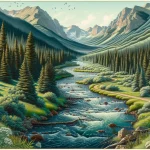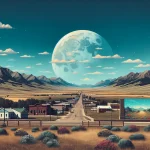From hiking and fishing to wildlife viewing and river rafting, the East Fork Cimarron River’s rugged natural beauty and wealth of activities provide the perfect destination for adventurers, nature lovers, families, and thrill-seekers alike.
In This Article
TL;DR
- The East Fork Cimarron River appeals with its gorgeous mountain scenery, a wealth of outdoor recreation, rich biodiversity, unique geology, and cultural heritage.
- Key activities include hiking, camping, fishing, rafting, mountain biking, wildlife viewing, photography, eco-tourism, and exploring historical landmarks.
- Conservation efforts strive to protect the local habitat while providing sustainable tourism opportunities.
A Remote Mountain Wilderness
Winding through the Cimarron River Valley beneath the towering peaks of the San Juan Mountains, the East Fork Cimarron River carves out a pristine wilderness sanctuary. It is a tributary of the Cimarron River, along with the Middle Fork Cimarron River and West Fork Cimarron River.
Largely isolated from major development and human impacts, the area harbors exceptional biodiversity across its forests, meadows, and alpine tundra. The river itself rushes over boulders and rapids, its cold waters brimming with trout and rich insect life to sustain native wildlife populations.
The valley also holds remnants of ancient glaciers and evidence of dramatic Pleistocene landscape evolution, offering insights into Colorado’s geological past. For outdoor enthusiasts, this remote mountain habitat promises exceptional hiking, camping, fishing, and wildlife viewing opportunities to experience nature at its most raw and unfiltered.
Immersing in Ute Tribal Traditions
The East Fork Cimarron River valley has been home to the Ute people for centuries, their rich cultural identity intrinsically woven into the landscape. Visiting the local Tabeguache Reservation offers opportunities to learn about Ute history and traditions while directly supporting the indigenous community. Tribal artisans display their intricate beadwork, leather crafts, and woven baskets at cultural centers and local markets.
Meanwhile, sites like the National Ute Trail trace centuries-old trade and hunting routes, reminding visitors of the Ute’s deep connection to the valley spanning generations. Attending annual events like the Sun Dance Festival provides an intimate glimpse at sacred customs and time-honored ceremonies that continue to define Ute life along the river today.
Adventures Galore Along the River
Hiking and Camping Through Alpine Scenery
Over 200 miles of hiking trails allow trekking through forests and meadows carpeted in wildflowers under the sheer cliffs and peaks of the surrounding mountains. The river also offers nearly unlimited camping options, whether in designated campgrounds or dispersed primitive sites to serve as the ultimate wilderness base camp.
Early summer presents a spectacular time to visit when snowmelt feeds the raging rapids, wildflowers burst into bloom, trees are full of vibrant green colors, and wildlife sightings reach their peak. But fall offers its own charms, with vibrant golden trees set against evergreen forests and crystal clear skies. There’s nothing quite like the beauty of a sunset amidst the beautiful landscape.
Nearby camping areas include Cimarron Campground within Curecanti National Recreation Area near Morrow Point Reservoir. Silver Jack Campground in Uncompahgre National Forest provides scenic camping near Silver Jack Reservoir, and Big Cimarron Campground in Big Cimarron Valley offers tent camping amidst forests with hiking and fly fishing access.
Beaver Lake Campground near Beaver Lake in Cimarron Range provides tent and RV camping with mountain views and trout fishing opportunities along the river.
Casting for Colorado River Trout
The East Fork Cimarron holds a healthy population of wild Rainbow and Brown trout perfectly adapted to the cold, fast-moving mountain waters. While remote, the river still provides excellent fly fishing access along Forest Service roads and trails paralleling the streambed. The section between Toltec Creek and Clear Creek is especially productive in early summer. But patient anglers can land trophy-sized trout throughout the river’s length into mid-fall by matching the plentiful hatches of caddis, mayflies, and stoneflies that sustain the year-round food chain.
Riding the Rapids Through Spectacular Gorges
During peak spring runoff, the Cimarron transforms into a thrilling whitewater destination, with rapids up to Class IV cascading through enchanting sandstone gorges. Commercial outfitters offer guided full-day rafting trips to navigate the roughest sections, while calmer segments allow do-it-yourself kayaking and pack raft adventures. Beyond the rapids, the main course winds smoothly past high desert mesas, perfect for multi-day excursions. Along the way, ancient petroglyphs etched into the canyon’s towering walls offer glimpses into the lives of past inhabitants.
Wildlife Spectacles in a Pristine Mountain Habitat
The diversity of high mountain terrain, forests, and meadows along the East Fork Cimarron River creates an ideal habitat for an exceptional variety of wildlife species. Herds of elk and mule deer graze across open meadows and aspen groves, the bugling bull elk announcing the fall rutting season. Bighorn sheep cling impossibly to steep canyon cliffs and rocky slopes dotted with pikas and yellow-bellied marmots.
Higher alpine reaches host Rocky Mountain goats negotiating precipitous ledges and horned ptarmigan blending into the tundra. Meanwhile, black bears, mountain lions, bobcats, red foxes, and coyotes range across all elevations. The river itself sustains populations of playful otters, busy beavers, and over 150 species of resident and migratory birds. Such abundant wildlife promises exceptional sightings for avid photographers and nature observers.
The East Fork Cimarron River flows through diverse mountain ranges like the Cimarron Range, showcasing peaks like Courthouse Mountain and Chimney Rock. Passing through the Uncompahgre Wilderness in the San Juan Mountains provides opportunities for hiking and wildlife viewing.
Near its headwaters, the river passes the scenic Silver Jack Reservoir area, ideal for camping and fishing. The lower part meanders through the Big Cimarron Valley, offering picturesque drives, hiking trails, camping areas, and stunning views of surrounding peaks and forests.
Capturing Colorado’s Wild Beauty Through the Lens
The raw, unspoiled mountain landscapes around the East Fork Cimarron River offer limitless inspiration for landscape and nature photographers. Sunrises and sunsets ignite fiery alpenglow on the San Juan peaks, and high clouds create ever-changing drama. Wildflowers bloom in summer meadows, while golden aspens contrast fall evergreens.
Dramatic overlooks highlight the river carving through red rock canyons. Plenty of wildlife offers subjects from intimate portraits to action scenes across mountain terrain. While stunning views abound along trails and overlooks, dedicated photographers can discover even more spectacular vantage points through backcountry hikes and pack rafting trips.
Remnants of Ancient Glaciers and Pleistocene Landscapes
While the alpine scenery enthralls visitors today, the East Fork Cimarron River valley reveals its geological history extends back over 65 million years into the late Cenozoic era. Advancing and retreating glaciers during the Pleistocene ice ages dramatically sculpted the landscape, carving U-shaped valleys, leaving polished granite behind, and depositing massive boulders and debris across the high mountain terrain.
Remnant glacial lakes and “kettles” now dot the valley, offering insights into the last glacial retreat. This rich geological record continues to attract scientists studying climate shifts and landscape evolution through changing environmental conditions. Casual visitors can also discover evidence of this dramatic natural history while exploring the rugged high country.
Promoting Responsible Tourism and Conservation
The East Fork’s remote wilderness character remains vulnerable even from limited human impacts. As visitation increases, proactive stewardship ensures minimal recreational impacts while sustaining the local forest, water, and wildlife habitats for future generations.
Responsible practices include strictly packing out all trash and waste, limiting campfires, and avoiding wildlife disturbances. However, visitors can also directly support local conservation efforts. San Juan National Forest and Cimarron State Parks manage sensitive habitats and recreation, while organizations like the Nature Conservancy purchase private lands for preservation.
Visitors passionate about sustaining this mountain sanctuary can volunteer for projects or donate to conservation trusts dedicated to its long-term protection.
Thrills and Relaxation for All Interests
While remote, the East Fork still presents activities for all interests and skill levels. Families relax at scenic riverside campgrounds and hike gentle trails through wildflower meadows. The Cimarron River Expeditions Center offers beginner-friendly rafting along the mellower Lower Cimarron. Adrenaline junkies can sign up to tackle Class IV rapids on the Upper East Fork. And miles of old mining roads and trails cater to mountain biking and OHV riding.
When ready to unwind, soaking in Toltec Creek Hot Springs or touring the historic mining towns of Cimarron and Silverton reveals the area’s cultural side. With such diverse adventures, the East Fork promises excitement for kids through seniors.
Immersing in Cultural Heritage
Beyond natural splendors, a rich vein of cultural heritage runs through the East Fork Cimarron River valley for visitors to tap into. Ancient Ute petroglyphs and campsites remind us of prehistoric inhabitants. Classic mining towns like Cimarron and Silverton, with their Victorian-era architecture, offer living glimpses into Colorado’s frontier era after the 1800s silver rush.
The Alpine Loop Backcountry Byway traces original stage and wagon routes through the San Juans. Museums like the Old West Heritage Museum and Mining Heritage Center showcase everything from Native American artifacts to mining equipment through rotating exhibits. By exploring these cultural sites, the East Fork comes alive not just with natural beauty but also the rich stories of people drawn here for over 10,000 years.
So whether seeking outdoor adventures, cultural immersion, or family relaxation, the East Fork Cimarron River promises an unforgettable Colorado mountain escape with experiences to satisfy any interest. Its rare blend of rugged wilderness, vibrant heritage, and diversity of activities beckons to be explored again and again.
FAQ
What is the best time of year to visit?
While spectacular year-round, May-October provides the best weather and accessibility. July-August is peak season with all amenities open, but also greater crowds. Late spring and fall offer fewer people, lower rates, gorgeous scenery, and wildlife sightings.
What lodging options are available nearby?
The Cimarron River Valley offers dispersed backcountry camping, developed campgrounds like Toltec Gorge, and dozens of vacation rentals. Silverton, Lake City, and Creede also provide hotels, motels, RV parks, and full-service resorts within a short drive.
Is the East Fork Cimarron River safe for non-expert paddlers?
Yes! Beginner and family-friendly paddling options exist along the Lower Cimarron. However, other sections contain advanced Class IV rapids that require guidance or expertise. Know your limitations and choose river segments accordingly.
Do I need any permits to hike or camp along the river?
No permits are needed for day hiking. Backcountry camping requires free permits available from the Grand Mesa, Uncompahgre, and Gunnison National Forest offices in Delta or Gunnison.






